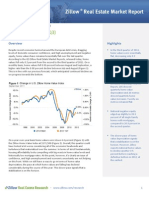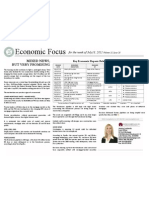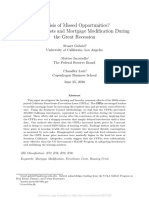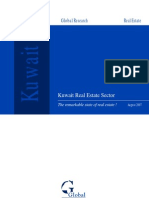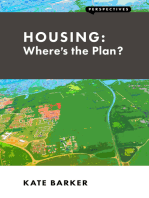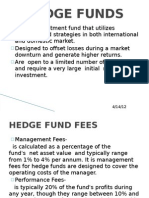0 ratings0% found this document useful (0 votes)
959 viewsQuarterly Report June 2011 FINAL
Quarterly Report June 2011 FINAL
Uploaded by
economicdelusionThe document summarizes data on the Australian construction industry, which is experiencing a cyclical low due to economic factors and natural disasters. Key points include:
- Approvals and employment in the construction sector declined further in the latest quarter, with job losses in full-time roles but gains in part-time work.
- Housing affordability is gradually improving and first home buyer activity is increasing, but overall conditions remain weak with approvals at their lowest levels in over a decade.
Copyright:
Attribution Non-Commercial (BY-NC)
Available Formats
Download as PDF, TXT or read online from Scribd
Quarterly Report June 2011 FINAL
Quarterly Report June 2011 FINAL
Uploaded by
economicdelusion0 ratings0% found this document useful (0 votes)
959 views6 pagesThe document summarizes data on the Australian construction industry, which is experiencing a cyclical low due to economic factors and natural disasters. Key points include:
- Approvals and employment in the construction sector declined further in the latest quarter, with job losses in full-time roles but gains in part-time work.
- Housing affordability is gradually improving and first home buyer activity is increasing, but overall conditions remain weak with approvals at their lowest levels in over a decade.
Copyright
© Attribution Non-Commercial (BY-NC)
Available Formats
PDF, TXT or read online from Scribd
Share this document
Did you find this document useful?
Is this content inappropriate?
The document summarizes data on the Australian construction industry, which is experiencing a cyclical low due to economic factors and natural disasters. Key points include:
- Approvals and employment in the construction sector declined further in the latest quarter, with job losses in full-time roles but gains in part-time work.
- Housing affordability is gradually improving and first home buyer activity is increasing, but overall conditions remain weak with approvals at their lowest levels in over a decade.
Copyright:
Attribution Non-Commercial (BY-NC)
Available Formats
Download as PDF, TXT or read online from Scribd
Download as pdf or txt
0 ratings0% found this document useful (0 votes)
959 views6 pagesQuarterly Report June 2011 FINAL
Quarterly Report June 2011 FINAL
Uploaded by
economicdelusionThe document summarizes data on the Australian construction industry, which is experiencing a cyclical low due to economic factors and natural disasters. Key points include:
- Approvals and employment in the construction sector declined further in the latest quarter, with job losses in full-time roles but gains in part-time work.
- Housing affordability is gradually improving and first home buyer activity is increasing, but overall conditions remain weak with approvals at their lowest levels in over a decade.
Copyright:
Attribution Non-Commercial (BY-NC)
Available Formats
Download as PDF, TXT or read online from Scribd
Download as pdf or txt
You are on page 1of 6
In aggregate, the latest quarter of industry data makes for
a depressing read indeed. The data paints a picture of an
industry at a cyclical low while also struggling with the
impacts of natural disasters. Whilst it is difficult to
separate underlying trends from the impacts of natural
disasters, it appears that the industry has at best been
tracking sideways since our last report. Over the quarter,
a further 4,090 full-time construction jobs have been lost,
housing finance is down a further 4.4% (quarter on
quarter) and approvals have slid another 18%, driven by
declines in the volatile unit and attached dwelling sector.
However, on the bright side, total construction
employment has risen by 2,573, courtesy of 6,663 part-
time jobs being created; the most recent monthly
observations for approvals and housing finance are up
from the lows of January and February; gradual
improvements in housing affordability have been
observed; and first-home buyers are representing an
increasing share of market activity.
Despite the weak figures, signs have emerged that the
worst is behind us and there is reason to be cautiously
RSWLPLVWLFWKDWFRQGLWLRQVZLOOLPSURYHE\\HDUVHQG
Developer finance is slowly freeing up with some
banks showing a willingness to increase their
exposure to property again.
First home buyer activity is likely to rise as
affordability improves (albeit gradually) courtesy of flat
to falling house prices and strong wages growth.
Households will become increasingly cashed up and
confident as the benefits of the resources boom start
to weave their way through the economy next year.
Interstate migration levels should rise in the coming
12 to 18 months as property becomes relatively more
affordable than in other states and the resource-led
recovery encourages job seekers to Queensland.
Risks remain with the potential for interest rate rises
beyond that anticipated by markets and higher building
costs courtesy of labour and capacity shortages.
The State Budget announcement of a $10,000 grant for
new home purchases will give a much needed and
overdue lift to construction activity and accelerate
industry recovery. Much more needs to be done,
however, to remove supply side obstacles to new
housing and reduce excessive new housing costs.
Hope ahead for industry at critical low
CONTENTS:
Industry Output ...................................................... 1-2
1. Approved Dwelling Units: Qld
2. Total Approved Dwellings: State Comparison
3. State Comparison for Approved Houses
4. State Comparison for Units and Attached Housing
5. House Approvals: SEQ and Regions
6. Apartment and Unit Approvals: SEQ and Regions
Underlying Demand................................................... 3
1. Over/Under Building Estimates: Qld
2. Home affordability
Population Growth .................................................... 3
1. Population Growth Components: Qld
2. Population Growth: State Comparisons
Finance Data .............................................................. 4
1. Value of Work Done: Qld
2. Loans for Owner Occupier Home Purchase: Qld
3. Owner Occupier Home Purchase Loans vs Dwelling
Approvals: Qld
4. Commercial Finance for New Dwellings
Employment ............................................................... 5
1. Construction Employment: Qld
2. Construction Employment and Building Approvals
3. Construction Employment by Region: Qld
When will prospects for developers improve? ...... 6
INDUSTRY OUTPUT
For approvals, Qld remains the state most affected since the GFC.
Annual Qld approvals are 33.7% below levels observed immediately
prior to the GFC (06/07- 07/08) and 26.7% below long-term averages.
NSW approvals are marginally higher for the year and slightly above
the 06/07--07/08 average but 23.5% below historical averages.
VIC is the national stand-out with approvals up 12.8% for the year and
well above pre-GFC and historical averages.
Approvals were down in WA and SA over the year and remain below
pre-GFC levels.
There were 5,646 private sector dwellings approved in the Apr-11
TXDUWHU- a decline of 18.7% on the previous quarter.
Public sector dwelling approvals also fell 13.7% over the quarter and
now represent only 3% of all approvals. At the height of the fiscal
stimulus, public sector approvals accounted for 16.4% of all activity.
Whilst approvals in the flood affected month of January were a
record low, on a quarterly basis approvals to Apr-11 are at levels
similar to that experienced in the midst of the GFC and one has to go
right back to the introduction of the GST to observe a lower figure.
Report 9, June 2011
2.
Total Approved Dwellings: State Comparison
(Annual, seasonally adjusted)
1.
Approved Dwelling Units: Qld
(Moving quarterly totals, seasonally adjusted)
Pg 1 of 6
Qld was hit hard by the GFC in 2008 but was temporarily boosted by
FHOG stimulus and lower interest rates in late 2009.
Qld detached house approvals were down 7.7% in the April quarter.
Detached approvals have risen on a monthly basis since flood affected
January, however have not fully recovered to Dec-10 levels.
There were 3,933 detached houses approved in the April quarter in Qld
- only 62% of historical average levels. Across the rest of Australia
detached housing approvals are running at around long-term average
levels thanks largely to strength in VIC.
In the April quarter detached house approvals fell 4.9% and 3.3% in VIC
and WA respectively and rose slightly in NSW (+1.8%) and SA (+1.2%).
UNDERLYING DEMAND
POPULATION GROWTH
Qld unit approvals collapsed in the April quarter - down 34% to be at
levels last seen in late 2009. Over the same period unit approvals fell
16% in both VIC and WA (albeit from a record high in VIC).
NSW unit approvals were down 1.2% over the quarter and up 46% in SA.
Recent unit approvals in Victoria are more than double historical average
levels.
NSW unit approvals have risen strongly since early 2009 after the
government announced infrastructure charge reductions, and followed up
ZLWKRIIWKHSODQVWDPSGXW\FKDQJHV
3.
State Comparison for Approved Houses
(Moving quarterly totals, seasonally adjusted)
4.
State Comparison for Units and Attached Housing
6.
House Approvals: South East Queensland
The Gold Coast area is consistently posting results well below pre-
GFC levels - around 600 per quarter lower.
Inner Brisbane unit approval numbers have been strong with 812
approved in the last six months.
While quarterly regional unit approvals are volatile, in general over
the last year approval levels have been running at less than one-
third of pre-GFC levels.
The units market has virtually stalled in the Far North region with
only 72 approvals in the last year.
Apartment, Unit Approvals: South East Queensland
House Approvals: Queensland Regions Apartment, Unit Approvals: Queensland Regions
5.
In the latest quarter, overall SEQ private sector detached house approvals
declined a further 7.4% and now sit 48% lower than the 06/07 - 07/08 aver-
age (which reflected overall SEQ Regional Plan targets). In the regions,
detached house approvals only partially recovered from the flood and cy-
clone impacted January quarter and remain 51% below the 06/07 - 07/08
average.
Gold Coast, Fitzroy and Northern Regions bucked the State trend and rose
strongly over the April quarter.
In SEQ, Outer Brisbane, Gold Coast and Moreton remain in the deepest
slumps sitting at 38%, 33% and 41% of 06/07 - 07/08 average levels. West
Moreton and Middle Brisbane have had the shallowest post-GFC down-
turns. In the Regions, the Far North is the weakest, down a further 16% with
detached house approvals now at only 27% of the 06/07 - 07/08 average.
Pg 2 of 6
(Quarterly, original)
(Quarterly, original)
(Quarterly, original)
(Quarterly, original)
(Moving quarterly totals, seasonally adjusted)
UNDERLYING DEMAND
POPULATION GROWTH
Apartment, Unit Approvals: South East Queensland
This graph draws on ABS population and home construction data and
uses industry estimates to compare housing supply to housing demand.
33,164 dwellings were commenced in Qld in 09/10, up 15% on 08/09, but
11% below the 20 year average. Commencements in 10/11 are on track to
be the lowest since immediately after the introduction of the GST, with
only 20,632 commenced in the nine months to 31 March 2011.
Based on population changes, underlying demand is estimated to be
around 37,000 dwellings in 10/11 - representing a shortfall of more than
9,000 dwellings. This is on top of many years of previously unmet
demand. The National Housing Supply Council estimates a gap in supply
of 56,100 dwellings from 2001-2009 (confirmed by UDIA (Qld) estimates).
Poor affordability, economic uncertainty and high input costs are
UHVWULFWLQJWKHLQGXVWU\VDELOLW\WRUHVSRQGWRWKLVXQGHUVXSSO\
1.
Over / Under Building Estimates: Qld
Qld population growth has been easing since Mar-09 and quarterly
growth is now 42% below that point. The latest quarter (Sep-10)
recorded population growth of 18,419. This is up around 1,000 on
Jun-10 result but 5,126 (or 22%) below the 2000s average.
Annual population growth at 82,187 is close to the 20 year average.
Annual net interstate migration of 8,399 is the lowest since current
records began in 1981 and is 69% below the long-term average.
While the Sep-10 quarter net overseas migration figure ticked up,
the annual rate of 33,827 is almost half that observed two years ago
due to a collapse in international student and UK and NZ arrivals.
1.
Population Growth Components: Qld
(Quarterly, original)
Recent years have seen strong population increases across all states
from higher birth rates and, until early 2009, from overseas migration.
Vic, NSW and SA are retaining more of their population than in earlier
times, helping compensate for lower overseas migration and keeping
population growth rates strong by historical standard.
WA has had reduced net interstate migration since early 2009
however experienced a significant jump in the Sep-10 quarter.
Population growth in the year to Sep-10 was: NSW 95,157 (1.3%);
Vic 90,464 (1.7%); Qld 82,187 (1.8%); WA 47,268 (2.1%); SA 17,435
(1.1%).
2. Population Growth: State Comparisons
(Quarterly, original)
Pg 3 of 6
(Annual 2001/022009/10, plus forecast to 2011/12)
This graph tracks the home buying power of a Brisbane family with a
median family income (25 year mortgage, 10% deposit, 30% of gross
income on repayments) and the median house price in Brisbane.
House prices grew strongly from 2002, creating a substantial
affordability gap for a Brisbane family earning a median income with a
difference of approximately $140,000 at March 2011.
Removing supply-side obstacles and reforms to reduce the excessive
cost of new housing are needed to close this affordability gap.
Over the last six months, price falls combined with stable interest rates
and strong wages growth has seen some narrowing of the affordability
gap.
Home Affordability
2.
(Quarterly)
FINANCE DATA
The value of engineering construction work done in Qld was largely
unchanged in the latest quarter (Mar-11) sitting at $5.16 billion.
Engineering continues to be the strongest performing sector.
The value of non-residential work undertaken was down 9.9% for the
Mar-11 quarter and down 12.7% on the same period last year. Activity
levels are the lowest since Mar-08.
The value of residential work done is down 5.2% over the Mar-11
quarter and 10% lower than the same period last year. Activity has not
been this low since Mar-02.
1.
Value of Work Done: Qld
(Annual % change, quarterly, seasonally adjusted)
Dramatic declines in the numbers of home loans issued during 2008
reversed strongly in 2009, assisted by the FHOG boost and low
interest rates. Reduction of the FHOG grant and interest rate rises
caused new declines.
Whilst owner occupier loans in the latest month, Apr-11, for both new
and existing home purchase, are 23% higher than in Jan-11, they
have not recovered to pre-flood levels.
Owner-Occupier Loans for the construction or purchase of a new
home were 28% lower in the April quarter compared to the same
period last year, and 15% lower for established homes (excluding
refinancing).
There were 2,420 owner-occupier loans for new construction in the
April quarteraround 75% of long-term average levels.
2.
Loans for Owner Occupier Home Purchase: Qld
(Moving quarterly, original)
This graph points to the significance of investor activity in housing
supply. An average of around 1,500 approvals per month in excess of
owner occupier loans has occurred over the last decade.
The GFC saw non-owner occupier housing activity collapse. Whilst
activity has recovered considerably, investor activity remains at only
around two-thirds of decade average levels.
3.
Owner Occupier Home Purchase Loans vs Dwelling
Approvals: Qld
(Monthly, original)
Pg 4 of 6
Cycle Analysis: Commercial Finance for New
Dwellings
4.
(Annual, original)
Commercial finance investment in new dwellings in the year to April
2011 was approximately $1bn well under half that observed
immediately prior to the GFC.
Four significant downturns can be identified from ABS records that
began January 1985.
The present downturn is the second longest and was the sharpest in
terms of the peak to trough ratio.
Although monthly figures can be volatile, the commercial finance figure
of $153m in March 2011 (the highest monthly figure since mid-2008) is
promising.
Full-time employee numbers decreased by 2% (or 4,090) in the construction sector
in the May quarternot unexpected given the weak dwelling approvals figures
earlier in the year.
Whilst part-time employment can be volatile from quarter to quarter, it was
encouraging to see a rise of 6,663 in the May quarter more than offsetting the fall in
full-time work.
From Nov-07, unemployment in the construction sector increased markedly peaking
at 14,311 four months after the monthly building approvals low in Jan-09. Most
recently 12,981 construction workers were unemployed (May 2011).
1.
Construction Employment: Qld
(Quarterly, Original)
Construction Employment by Region: Qld
(Full time, statistical regions, original)
Construction and development activity is a major source of direct and flow-on employment. UDIA
(Qld) research shows the industry ranked between 2
nd
and the 9
th
largest employer in 2007-08
across the state. Shifts in development activity and employment can have a substantial effect on
local economies.
Full-time employment grew strongly on the Gold Coast and in the Mackay region in the May
quarter. Significant employment losses were observed in Middle and Outer Brisbane and in the
Darling Downs-South West region with floods most likely playing a role.
Looking through the short-term volatility, employment numbers have struggled to recover post
GFC in particular on the Sunshine Coast and in the Wide-Bay Burnett Region. The greatest
employment resilience has occurred in Inner, South and East Brisbane, Mackay and the Northern
region. Despite weak approvals figures, Gold Coast and Far North employment has been steadily
rising (albeit with a dip in the most recent quarter in the Far North).
FINANCE DATA EMPLOYMENT
3.
2.
Construction employment is closely correlated with approval
figures with a lag of about three months. Historically each
additional home approval is associated with the employment
of two additional construction workers.
Whilst approvals fell sharply during the flood affected months,
employers appear to have replaced full-time with part-time
workers rather than lay off staff entirely.
Construction Employment and Building Approvals: Qld
(Annual, original)
Pg 5 of 6
4.
Construction Employment by Region: Qld
(Full time, statistical regions, original)
This report is produced by the Urban Development
Institute of Australia (Queensland), using an
aggregation of data provided by the Australian Bureau
of Statistics.
Any representation, statement, opinion or advice,
expressed/implied in this publication is made in good
faith but on the basis that UDIA (Qld), its members and
employees are not liable to any person for any damage
or loss whatsoever which has occurred or may occur in
relation to that person taking or not taking action in
respect to any representation, statement, opinion or
advice referred to above.
Pg 6 of 6
By Gary Emmett, Construction Economist, Turner & Townsend
I think that the prospects for development and
private construction will gradually improve from
mid year. Right now the official statistics show
an economy with several weaknesses.
Approvals and commencements were very low
in the first half of the year. We have also seen
weaker consumer confidence, a dip in house
prices and a slowing of full time job creation.
However official statistics are 2-3 months old
by the time they are published and the natural
disasters in Queensland had much to do with
the poor figures. It gets better from here.
State finances including the proceeds of state
asset sales were severely damaged by the
flood reconstruction costs and falling royalties
and tax receipts, and the state is likely to end
up with zero growth for the 2010-11 year. The
government will feel hobbled by the prospect of
further budget deficits. However in his budget
the Treasurer was eager to point to the
resources driven recovery that is coming and
according to Treasury estimates will add 5% to
growth in 2011-12, and 5.25% in 2012-13.
This is a pause with residential and commercial
construction in a cyclical downturn and post
BER hangover. The major part of the resources
construction boom is not here yet but the
forecast investment in coal and gas projects is
huge, and much of it is committed (locked in).
In the interim the announcement of a short
term $10,000 grant for new home purchases
will give a welcome boost to new housing
construction. On the downside this will be paid
for by ending the stamp duty exemption on
home upgrades, and that could add temporary
weakness to established house prices.
However those businesses that can take
advantage of competitive construction costs
and an improving lending environment will be
able to deliver projects just as the market
improves. Those that can position themselves
to take advantage of the coming resources
boom (however indirectly) will prosper. By late
in 2012 the high levels of construction in gas
and coal will start to feed through to other
sectors of the economy, presenting many
opportunities. Gradually the resources
construction bonanza will trickle its way into the
broader economy. One source of growth will be
more jobs and higher wages, which will fuel
demand for housing and condominiums, retail,
vehicles and boats.
The other source of growth will be though the
numerous supplier industries such as
maintenance, machine tools, materials, and
services such as accounting, engineering,
legal, transport and IT. Supplier industries will
need premises to service their large clients.
This includes warehouses, workshops and
offices. Given the benign outlook for
construction costs, developments starting now
can be built on budget and will come to market
as it improves. At first this will occur in the
muscle towns of Gladstone, Mackay and
Townsville, but later it will trickle down to the
South East.
Our construction cost forecasts show only
moderate increases until late 2012. At that
point we will begin to feel the impact of the
resources construction boom and the labour
and capacity shortages.
This is not a replay of the nineties, when house
prices and development stagnated for up to six
years. Unlike then, we have very low
unemployment, moderate interest rates (for
now), inflation is in check, and resources
exports are strong.
The recent jobs data showing a slowing of full
time job creation will satisfy the RBA that wage
price inflation is not about to break out yet and
they should hold off interest rate rises for now.
For developers fearful that higher interest rates
will kill off residential projects look for
commercial and industrial projects where
interest rates are less important.
The banks are starting to lend for property
development again. Interestingly many are not
looking for high pre-commitments on short
duration small residential developments (up to
20 apartments). For some developers this may
represent an opportunity. For others (with
equity, or the ability to proceed without heavy
pre-commitments), construction costs will be
surprisingly favourable.
Some sectors of the economy will do very well
from the resources construction boom, but
other sectors will suffer and the effect may be
permanent. We will continue to look for signs
that the prospects for developers are
improving, and we think it is coming, but right
now this is the downturn part of the
construction cycle. Residential prices are
ahead of themselves and some further
weakness is inevitable. Stay positive, look at
how you can get exposure to the resources
boom, and things will get better.
If you would like to read more commentary from our Construction
Economist - v|s|t Turner & Townsend's www.costweb.com.au.
When will prospects for developers improve?
2011-1 2011-2 2011-3 2011-4 2012-1 2012-2 2012-3 2012-4
NSW 100 100 100 101 101 102 102 103
QLD 100 101 102 102 102 102 103 104
VIC 100 101 101 102 103 103 104 104
WA 100 101 101 102 103 103 104 105
SA 100 100 100 101 101 102 102 103
Table: Construction Costs Forecast. Competitive tender prices and a slow pickup in activity will keep construction costs
moderate during 2011 with larger increases likely in late 2012.
You might also like
- Nearly Bulletproof Setups 29 Proven Stock Market Trading Strategies (Etc.) (Z-Library)Document126 pagesNearly Bulletproof Setups 29 Proven Stock Market Trading Strategies (Etc.) (Z-Library)Ajay BhattacharjeeNo ratings yet
- Lazy Dog CaféDocument19 pagesLazy Dog Cafékbacelic100% (4)
- Inventory Flowrate Flowtime: E) None of The AboveDocument8 pagesInventory Flowrate Flowtime: E) None of The AboveAmir Faisal0% (1)
- Barilla SpA Case StudyDocument5 pagesBarilla SpA Case Studybinzidd007No ratings yet
- 2013 March 27 NZ Outlook Housing and InflationDocument3 pages2013 March 27 NZ Outlook Housing and InflationjomanousNo ratings yet
- Residex Quarterly Report - Sep 2013Document13 pagesResidex Quarterly Report - Sep 2013cclan05No ratings yet
- Property Report MelbourneDocument0 pagesProperty Report MelbourneMichael JordanNo ratings yet
- HIA Dwelling Approvals (10 September 2013)Document5 pagesHIA Dwelling Approvals (10 September 2013)leithvanonselenNo ratings yet
- CMHC 2015 Northern Housing ReportDocument13 pagesCMHC 2015 Northern Housing ReportAqukkasukNo ratings yet
- Builders Utlook: Housing Recovery Picks Up Steam Despite Persistent HeadwindsDocument16 pagesBuilders Utlook: Housing Recovery Picks Up Steam Despite Persistent HeadwindsTedEscobedoNo ratings yet
- New Zealand Economics: Anz ResearchDocument16 pagesNew Zealand Economics: Anz ResearchshreyakarNo ratings yet
- Bienville Macro Review (U.S. Housing Update)Document22 pagesBienville Macro Review (U.S. Housing Update)bienvillecapNo ratings yet
- Crockers Market Research: Further Growth For House Sales, in TimeDocument2 pagesCrockers Market Research: Further Growth For House Sales, in Timepathanfor786No ratings yet
- Zillow Q3 Real Estate ReportDocument4 pagesZillow Q3 Real Estate ReportLani RosalesNo ratings yet
- Economic Focus 9-26-11Document1 pageEconomic Focus 9-26-11Jessica Kister-LombardoNo ratings yet
- 4.29.14 CED Report PDFDocument17 pages4.29.14 CED Report PDFRecordTrac - City of OaklandNo ratings yet
- Australian Housing Chartbook July 2012Document13 pagesAustralian Housing Chartbook July 2012scribdooNo ratings yet
- Economic Focus 7-18-11Document1 pageEconomic Focus 7-18-11Jessica Kister-LombardoNo ratings yet
- Fiscal Policy, Politics and Weather Patterns... : Julie WillisDocument4 pagesFiscal Policy, Politics and Weather Patterns... : Julie WillisJulie Crismond WillisNo ratings yet
- Americas Rental HousingDocument36 pagesAmericas Rental HousingMariaNugrahiniNo ratings yet
- RBNZ Perspectives On Housing (April 2013)Document12 pagesRBNZ Perspectives On Housing (April 2013)leithvanonselenNo ratings yet
- Home Economic Report Oct 21Document2 pagesHome Economic Report Oct 21Adam WahedNo ratings yet
- Whangarei District Growth ModelDocument15 pagesWhangarei District Growth ModeljrcherrieNo ratings yet
- Westpac - Where Have The FHBs Gone (August 2013)Document6 pagesWestpac - Where Have The FHBs Gone (August 2013)leithvanonselenNo ratings yet
- Crisis of MissedDocument49 pagesCrisis of MissedForeclosure FraudNo ratings yet
- Good MorningDocument2 pagesGood Morningapi-246821370No ratings yet
- Keeping North Carolina's Housing AffordableDocument24 pagesKeeping North Carolina's Housing AffordableCato InstituteNo ratings yet
- Housing and The EconomyDocument17 pagesHousing and The EconomyNima MoaddeliNo ratings yet
- 2017 NJ Real Estate Market Statistics PresentationDocument46 pages2017 NJ Real Estate Market Statistics PresentationalekslinkNo ratings yet
- Morningstar - RobertDocument7 pagesMorningstar - Robertcfasr_programsNo ratings yet
- Commercial Real Estate Outlook 2012 11Document8 pagesCommercial Real Estate Outlook 2012 11National Association of REALTORS®No ratings yet
- 2022 Demand Research Executive Summary Final RfsDocument7 pages2022 Demand Research Executive Summary Final RfspaquitNo ratings yet
- Strategy Radar - 2012 - 0406 XX Oz Housing MarketDocument3 pagesStrategy Radar - 2012 - 0406 XX Oz Housing MarketStrategicInnovationNo ratings yet
- CRE Long Memo Nov2011Document8 pagesCRE Long Memo Nov2011shadesofyellow03No ratings yet
- 2022 NMHC Naa Demand Report Final Full Report RfsDocument193 pages2022 NMHC Naa Demand Report Final Full Report RfspaquitNo ratings yet
- The Australia EconomyDocument14 pagesThe Australia EconomyEL LANo ratings yet
- CREB Forecast 2011 Update (August Revision)Document20 pagesCREB Forecast 2011 Update (August Revision)Mike FotiouNo ratings yet
- Lael Brainard, "Restoring Price Stability in An Uncertain Economic Environment."Document9 pagesLael Brainard, "Restoring Price Stability in An Uncertain Economic Environment."Subin AryalNo ratings yet
- RLB International Report First Quarter 2012Document36 pagesRLB International Report First Quarter 2012Chris GonzalesNo ratings yet
- Ministry of Finance - Potential Implications of Reducing Foreign Ownership of BC's Housing MarketDocument10 pagesMinistry of Finance - Potential Implications of Reducing Foreign Ownership of BC's Housing MarketCKNW980No ratings yet
- Monetary Policy Report - CanadaDocument12 pagesMonetary Policy Report - CanadaHeenaNo ratings yet
- Kuwait Aug 07Document157 pagesKuwait Aug 07mfaisalidreisNo ratings yet
- June 2014 Building Approvals - National Media ReleaseDocument1 pageJune 2014 Building Approvals - National Media ReleaseMichael CourtenayNo ratings yet
- Onsumer Atch Anada: Canadian Housing Prices - Beware of The AverageDocument4 pagesOnsumer Atch Anada: Canadian Housing Prices - Beware of The AverageSteve LadurantayeNo ratings yet
- Qatar Real Estate 112007Document50 pagesQatar Real Estate 112007neettiyath1No ratings yet
- Swiss Re Canada Economic Outlook 3Q19Document2 pagesSwiss Re Canada Economic Outlook 3Q19Fox WalkerNo ratings yet
- BibliographyDocument7 pagesBibliographydontatme88No ratings yet
- JP Morgam GDPDocument2 pagesJP Morgam GDPbubbleuppNo ratings yet
- Global Recession and RecoveryDocument54 pagesGlobal Recession and RecoveryPaven RajNo ratings yet
- QMM Issue32 Boettcher RealtyDocument56 pagesQMM Issue32 Boettcher RealtyBoettcher RealtyNo ratings yet
- Illinois Revenue Nov 2014Document6 pagesIllinois Revenue Nov 2014Lennie JarrattNo ratings yet
- MS Sales EnergyDocument2 pagesMS Sales EnergyLuanNo ratings yet
- Housing Data Wrap-Up: December 2012: Economics GroupDocument7 pagesHousing Data Wrap-Up: December 2012: Economics GroupAaron MaslianskyNo ratings yet
- Economic Insight Report-30 Sept 15Document2 pagesEconomic Insight Report-30 Sept 15Anonymous hPUlIF6No ratings yet
- 2010 0113 EconomicDataDocument11 pages2010 0113 EconomicDataArikKanasNo ratings yet
- The Double Whammy About To Hit PropertyDocument10 pagesThe Double Whammy About To Hit PropertyHemil DeshmukhNo ratings yet
- Studiu - Constructii - Risc - 2012Document20 pagesStudiu - Constructii - Risc - 2012Tanasa CarmenNo ratings yet
- West Palm Beach 4Q11 AptDocument4 pagesWest Palm Beach 4Q11 AptAnonymous Feglbx5No ratings yet
- Personal Finance 101 Canada’S Housing Market Analysis Buying Vs Renting a Home: A Case StudyFrom EverandPersonal Finance 101 Canada’S Housing Market Analysis Buying Vs Renting a Home: A Case StudyNo ratings yet
- Global Housing Crisis: Housing Shortage Or Housing Glut? Which Is Better?From EverandGlobal Housing Crisis: Housing Shortage Or Housing Glut? Which Is Better?No ratings yet
- ABS - BoT Nov 2013Document44 pagesABS - BoT Nov 2013economicdelusionNo ratings yet
- Business Activity Expected To Lift in 2014Document9 pagesBusiness Activity Expected To Lift in 2014economicdelusionNo ratings yet
- Pmi Dec 2013 Report FinalDocument2 pagesPmi Dec 2013 Report FinaleconomicdelusionNo ratings yet
- Euro PMI March 2013Document3 pagesEuro PMI March 2013economicdelusionNo ratings yet
- Second Estimate For The Q2 2013 Euro GDPDocument6 pagesSecond Estimate For The Q2 2013 Euro GDPeconomicdelusionNo ratings yet
- Walking Back From CyprusDocument3 pagesWalking Back From CypruseconomicdelusionNo ratings yet
- IMF Working Paper - Jan. 2013Document43 pagesIMF Working Paper - Jan. 2013Spiros GanisNo ratings yet
- ECB Monetary Policy Developments Dec 2012Document6 pagesECB Monetary Policy Developments Dec 2012economicdelusionNo ratings yet
- Pci Dec12 Final ReportDocument2 pagesPci Dec12 Final ReporteconomicdelusionNo ratings yet
- Euro Area Unemployment Rate at 11.8%Document4 pagesEuro Area Unemployment Rate at 11.8%economicdelusionNo ratings yet
- US Budget and Debt - OI #1 2013Document2 pagesUS Budget and Debt - OI #1 2013economicdelusionNo ratings yet
- Student Lifecycle Management Extended Booking Check CookbookDocument22 pagesStudent Lifecycle Management Extended Booking Check Cookbookfairdeal2k1No ratings yet
- Methods For International StaffingDocument3 pagesMethods For International StaffingTalhaNo ratings yet
- Composite Construction Works For CNG Station at Kovvur, West Godavari District, A.PDocument209 pagesComposite Construction Works For CNG Station at Kovvur, West Godavari District, A.Pvinay1999No ratings yet
- Types of MallDocument10 pagesTypes of MallkelkararNo ratings yet
- N440 - ENTREPRENEURSHIP AND BUSINESS MANAGEMENT N4 P1 QP JUNE 2020 EditedDocument6 pagesN440 - ENTREPRENEURSHIP AND BUSINESS MANAGEMENT N4 P1 QP JUNE 2020 Editedzinhlemachaea4No ratings yet
- Ed Unit 1Document25 pagesEd Unit 1Ramalingam Chandrasekharan100% (1)
- Break-Even Point NotesDocument3 pagesBreak-Even Point NotesMinu Mary Jolly100% (1)
- RA 6810 Magna Carta For Countryside and Barangay Business Enterprises Kalakalan 20Document4 pagesRA 6810 Magna Carta For Countryside and Barangay Business Enterprises Kalakalan 20Tribung ManggugubatNo ratings yet
- Benchmark Report 2021 For FreelancersDocument43 pagesBenchmark Report 2021 For FreelancerskarakokosNo ratings yet
- Normal Balance For AssetsDocument2 pagesNormal Balance For AssetsAshhyyNo ratings yet
- Résumé GUSTAVO NEFFA DEC-07 EnglishDocument1 pageRésumé GUSTAVO NEFFA DEC-07 EnglishgneffaNo ratings yet
- Intraday Trading StrategiesDocument36 pagesIntraday Trading StrategiesRony Khan0% (1)
- Facilities Planning and DesignDocument2 pagesFacilities Planning and DesignShylaja_j0% (1)
- Lafarge Cement v. Continental Cement - 443 SCRA 522Document6 pagesLafarge Cement v. Continental Cement - 443 SCRA 522alilramones100% (1)
- Imageview Management LTD V Jack: (2009) Ewcaciv 63Document17 pagesImageview Management LTD V Jack: (2009) Ewcaciv 63Joshua ChanNo ratings yet
- BCG MatrixDocument3 pagesBCG MatrixMaheenNo ratings yet
- BDO V CIR CTA CASE NO 6588Document9 pagesBDO V CIR CTA CASE NO 6588Ruther Marc P. NarcidaNo ratings yet
- 7 Business ExpDocument60 pages7 Business ExpKeat Eing WongNo ratings yet
- TrusteeDocument19 pagesTrusteeArunaMLNo ratings yet
- Hedge FundsDocument10 pagesHedge FundsAnusha Danish KhanNo ratings yet
- FedGlobal ACH PaymentsDocument2 pagesFedGlobal ACH PaymentscrazytrainNo ratings yet
- 401 Midterm PracticeDocument15 pages401 Midterm PracticeNilanjona BalikaNo ratings yet
- Conduct of Monetary Policy Goal and TargetsDocument12 pagesConduct of Monetary Policy Goal and TargetsSumra KhanNo ratings yet
- Tax Invoice/Bill of Supply/Cash Memo: (Original For Recipient)Document1 pageTax Invoice/Bill of Supply/Cash Memo: (Original For Recipient)Mr GNo ratings yet
- Embedded Customization Course 10.0.700Document70 pagesEmbedded Customization Course 10.0.700nerz8830No ratings yet
- Kalakalappu (U) : Your Ticket(s) Confirmed!Document1 pageKalakalappu (U) : Your Ticket(s) Confirmed!GouthamNo ratings yet













